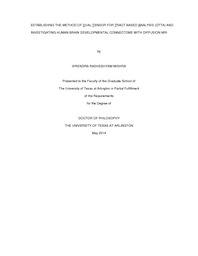
ATTENTION: The works hosted here are being migrated to a new repository that will consolidate resources, improve discoverability, and better show UTA's research impact on the global community. We will update authors as the migration progresses. Please see MavMatrix for more information.
Show simple item record
| dc.contributor.author | Mishra, Virendra Radheshyam | en_US |
| dc.date.accessioned | 2014-07-14T20:21:56Z | |
| dc.date.available | 2014-07-14T20:21:56Z | |
| dc.date.issued | 2014-07-14 | |
| dc.date.submitted | January 2014 | en_US |
| dc.identifier.other | DISS-12537 | en_US |
| dc.identifier.uri | http://hdl.handle.net/10106/24401 | |
| dc.description.abstract | Diffusion MRI (dMRI) has the unique ability of studying white matter fiber structure in the human brain in-vivo. The trajectory of the white matter fibers inside the brain can be mapped using the tractography techniques and their structural integrity can be assessed with the help of various metrics such as fractional anisotropy (FA) derived from diffusion tensor imaging (DTI). But with typical dMRI in clinical applications, almost half of human brain white matter (WM) voxels has crossing-fiber regions (CFR) where WM microstructural integrity is significantly underestimated with single tensor FA. A technique adapted to WM tract analysis and correcting the anisotropy bias at the CFR for dMRI acquired within 5 minutes in clinical research needs to be developed and was the goal of Aim 1. Other than FA, various other DTI derived metrics such as radial (RD), axial (AxD) and mean diffusivity (MD) have been used to noninvasively assess the microstructural development of human brain WM. At birth, most of the major WM tracts are apparent but in a relatively disorganized pattern. Brain maturation is a process of establishing organized pattern of these major WM tracts. However, the change in the spatial-temporal linkage pattern of major WM tracts during development remains unclear and evaluating the linkage pattern of major WM tracts during development was the goal of Aim 2. Moreover, the linkage pattern observed at birth is a result of complicated molecular and biochemical processes which take place during perinatal brain development and reshape the later brain structural network for sophisticated functional and cognitive requirements. However, structural topological configuration of human brain during this specific development period is not well understood and was the goal of Aim 3. To evaluate Aim 1, novel dual tensor tract analysis (DTTA) was developed that includes dual tensor fitting with Gaussian mixture model and tract analysis. Digital phantom was designed and dMRI with multiple b values was acquired to evaluate the accuracy of estimated tract-specific anisotropy at CFR after DTTA correction. The results from phantom study showed high accuracy of the corrected anisotropy with DTTA. The results from normal human dMRI used in clinical research indicated effective identification of CFR and correction of tract-specific anisotropy. Corrected anisotropy with DTTA is highly consistent to the single fiber FA within the same tract. The results suggest great potential of DTTA in estimating accurate tract-specific anisotropy at CFR and conducting tract analysis in clinical research. To evaluate Aim 2, diffusion magnetic resonance image (dMRI) data of 26 neonates and 28 children around puberty was acquired. 10 major WM tracts, representing four major tract groups involved in distinctive brain functions, were traced with DTI tractography for all 54 subjects. With the 10 by 10 correlation matrices constructed with Spearman's pairwise inter-tract correlations and based on tract-level measurements of FA, RD, AxD and MD of both age groups, we assessed if the inter-tract correlations become stronger from birth to puberty. In addition, hierarchical clustering was performed based on the pairwise correlations of WM tracts to reveal the clustering pattern for each age group and evaluate the pattern shift from birth to puberty. Stronger and enhanced microstructural inter-tract correlations were found during development from birth to puberty. The linkage patterns of two age groups differ due to brain development. These changes of microstructural correlations from birth to puberty suggest inhomogeneous but organized myelination processes which cause the reshuffled inter-tract correlation pattern and make homologous tracts tightly clustered. It opens a new window to study WM tract development and can be potentially used to investigate atypical brain development due to neurological or psychiatric disorders. To evaluate Aim 3, dMRI of 15 in-vivo human brains in the age range of 31 gestational weeks (wg) to 41wg were acquired to characterize structural brain network during perinatal brain development. dMRI tractography was used to construct structural brain networks and the underlying topological properties were quantified by graph-theory approaches. Small-world attributes were found to be evident throughout the perinatal brain development. Our results reveal a perinatal brain "connectome" that shows monotonically increasing network derived metrics and stronger networks with development, which is likely to be the outcome of both strengthening of major white-matter tracts and pruning of small fibers. | en_US |
| dc.description.sponsorship | Huang, Hao | en_US |
| dc.language.iso | en | en_US |
| dc.publisher | Biomedical Engineering | en_US |
| dc.title | Establishing The Method Of Dual-tensor For Tract Based Analysis (DTTA) And Investigating Human Brain Developmental Connectome With Diffusion MRI | en_US |
| dc.type | Ph.D. | en_US |
| dc.contributor.committeeChair | Huang, Hao | en_US |
| dc.degree.department | Biomedical Engineering | en_US |
| dc.degree.discipline | Biomedical Engineering | en_US |
| dc.degree.grantor | University of Texas at Arlington | en_US |
| dc.degree.level | doctoral | en_US |
| dc.degree.name | Ph.D. | en_US |
Files in this item
- Name:
- Mishra_uta_2502D_12537.pdf
- Size:
- 8.214Mb
- Format:
- PDF
This item appears in the following Collection(s)
Show simple item record


